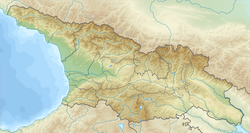Tiflis
| Tbilisi თბილისი |
||||||||
|---|---|---|---|---|---|---|---|---|
From top: View of Tbilisi,
Holy Trinity Cathedral (Sameba), Kartlis Deda, Abanotubani, view from Narikala, Narikala Fortress |
||||||||
|
||||||||
| Location of Tbilisi in Georgia | ||||||||
| Coordinates: 41°43′N 44°47′E / 41.717°N 44.783°ECoordinates: 41°43′N 44°47′E / 41.717°N 44.783°E | ||||||||
| Country |
|
|||||||
| Established | c. 479 A.D | |||||||
| Government | ||||||||
| • Mayor | David Narmania | |||||||
| Area | ||||||||
| • City | 720 km2 (280 sq mi) | |||||||
| Highest elevation | 770 m (2,530 ft) | |||||||
| Lowest elevation | 380 m (1,250 ft) | |||||||
| Population (2014) | ||||||||
| • City | 1,118,035 | |||||||
| • Density | 3,194.38/km2 (8,273.4/sq mi) | |||||||
| • Metro | 1,485,293 | |||||||
| Demonym(s) | Tbilisian Tbilisite |
|||||||
| Time zone | Georgian Time (UTC+4) | |||||||
| Area code(s) | +995 32 | |||||||
| Website | http://www.tbilisi.gov.ge/ | |||||||
|
|
|||||||||||||||||
|
|
|
|
|
|
|
|
|
||||||||||
|---|---|---|---|---|---|---|---|---|---|---|---|---|---|---|---|---|---|
| 1801-3 | 4,300 | 21.5% | 14,860 | 74.3% |
|
|
20,000 | ||||||||||
| 1864/65 winter | 14,878 | 24.8% | 28,404 | 47.3% | 12,462 | 20.7% | 60,085 | ||||||||||
| 1864/65 summer | 14,787 | 20.8% | 31,180 | 43.9% | 12,142 | 17.1% | 71,051 | ||||||||||
| 1876 | 22,156 | 21.3% | 37,610 | 36.1% | 30,813 | 29.6% | 104,024 | ||||||||||
| 1897 | 47,133 | 29.5% | 41,151 | 36.4% | 44,823 | 28.1% | 159,590 | ||||||||||
| 1926 | 112,014 | 38.1% | 100,148 | 34.1% | 45,937 | 15.6% | 294,044 | ||||||||||
| 1939 | 228,394 | 44% | 137,331 | 26.4% | 93,337 | 18% | 519,220 | ||||||||||
| 1959 | 336,257 | 48.4% | 149,258 | 21.5% | 125,674 | 18.1% | 694,664 | ||||||||||
| 1970 | 511,379 | 57.5% | 150,205 | 16.9% | 124,316 | 14% | 889,020 | ||||||||||
| 1979 | 653,242 | 62.1% | 152,767 | 14.5% | 129,122 | 12.3% | 1,052,734 | ||||||||||
| 2002 | 910,712 | 84.2% | 82,586 | 7.6% | 32,580 | 3% | 1,081,679 | ||||||||||
| 2014 | 996,804 | 89.9% | 53,409 | 4.8% | 13,350 | 1.2% | 1,108,717 | ||||||||||
Tbilisi (Georgian: თბილისი [tʰˈbiliˌsi]), commonly known by its former name Tiflis, and often mispronounced as Tiblisi, is the capital and the largest city of Georgia, lying on the banks of the Kura River with a population of roughly 1.5 million inhabitants. Founded in the 5th century by the monarch of Georgia's ancient precursor the Kingdom of Iberia, Tbilisi has since served, with intermissions, as the capital of various Georgian kingdoms and republics. Under Russian rule, from 1801 to 1917 Tiflis was the seat of the Imperial Viceroy governing both sides of the entire Caucasus.
Located on the crossroads of Europe and Asia, Tbilisi's proximity to lucrative east-west trade routes often made the city a point of contention between various rival empires throughout history and the city's location to this day ensures its position as an important transit route for global energy and trade projects. Tbilisi's varied history is reflected in its architecture, which is a mix of medieval, classical, Middle Eastern, Art Nouveau, Stalinist and Modernist structures.
Historically, Tbilisi has been home to people of diverse cultural, ethnic, and religious backgrounds, though it is overwhelmingly Eastern Orthodox Christian. Notable tourist destinations include cathedrals like Sameba and Sioni, classical Freedom Square, Rustaveli Avenue and Agmashenebeli Avenue, medieval Narikala Fortress, pseudo-Moorish Opera Theater, and the Georgian National Museum.
...
Wikipedia









